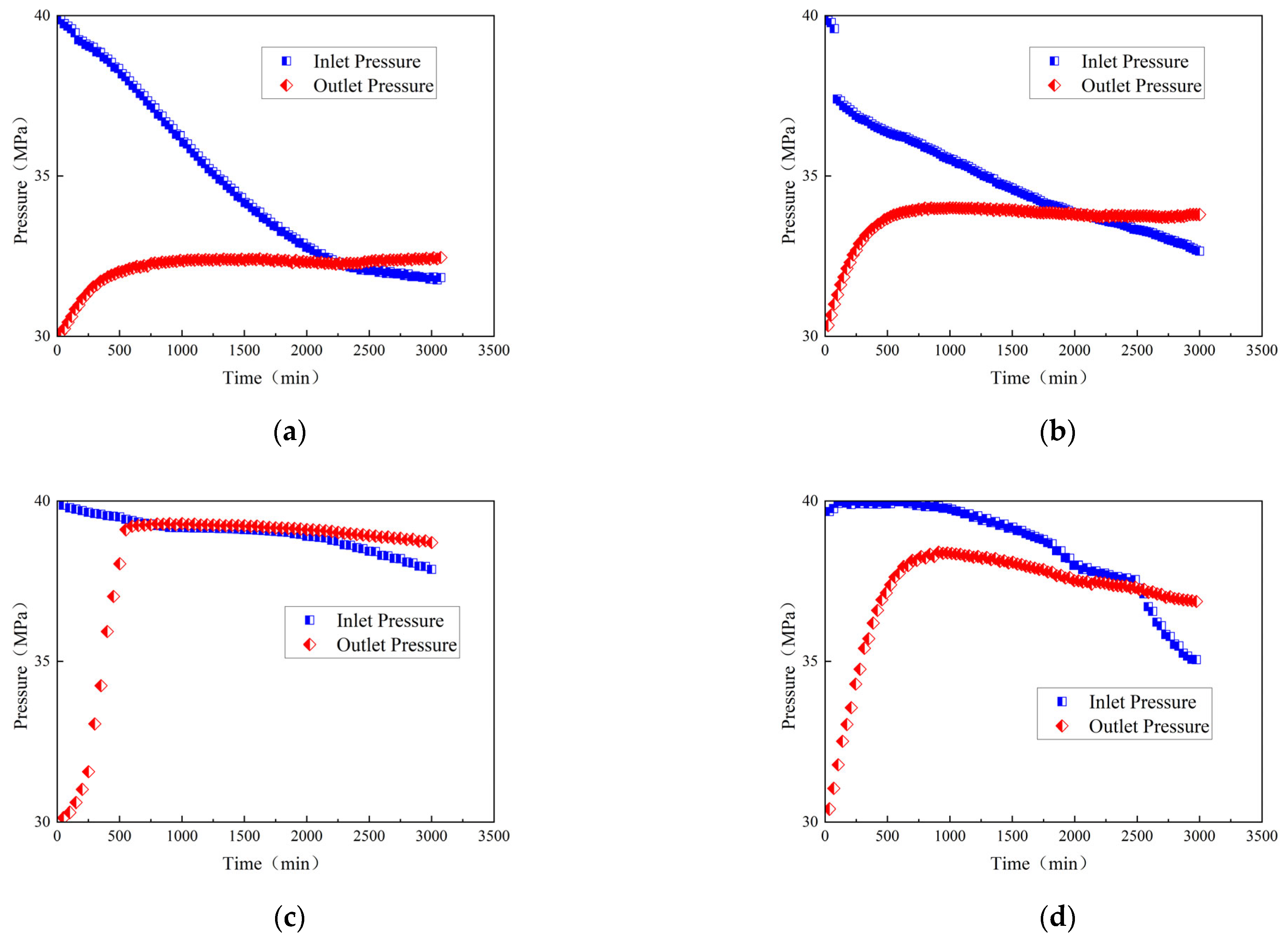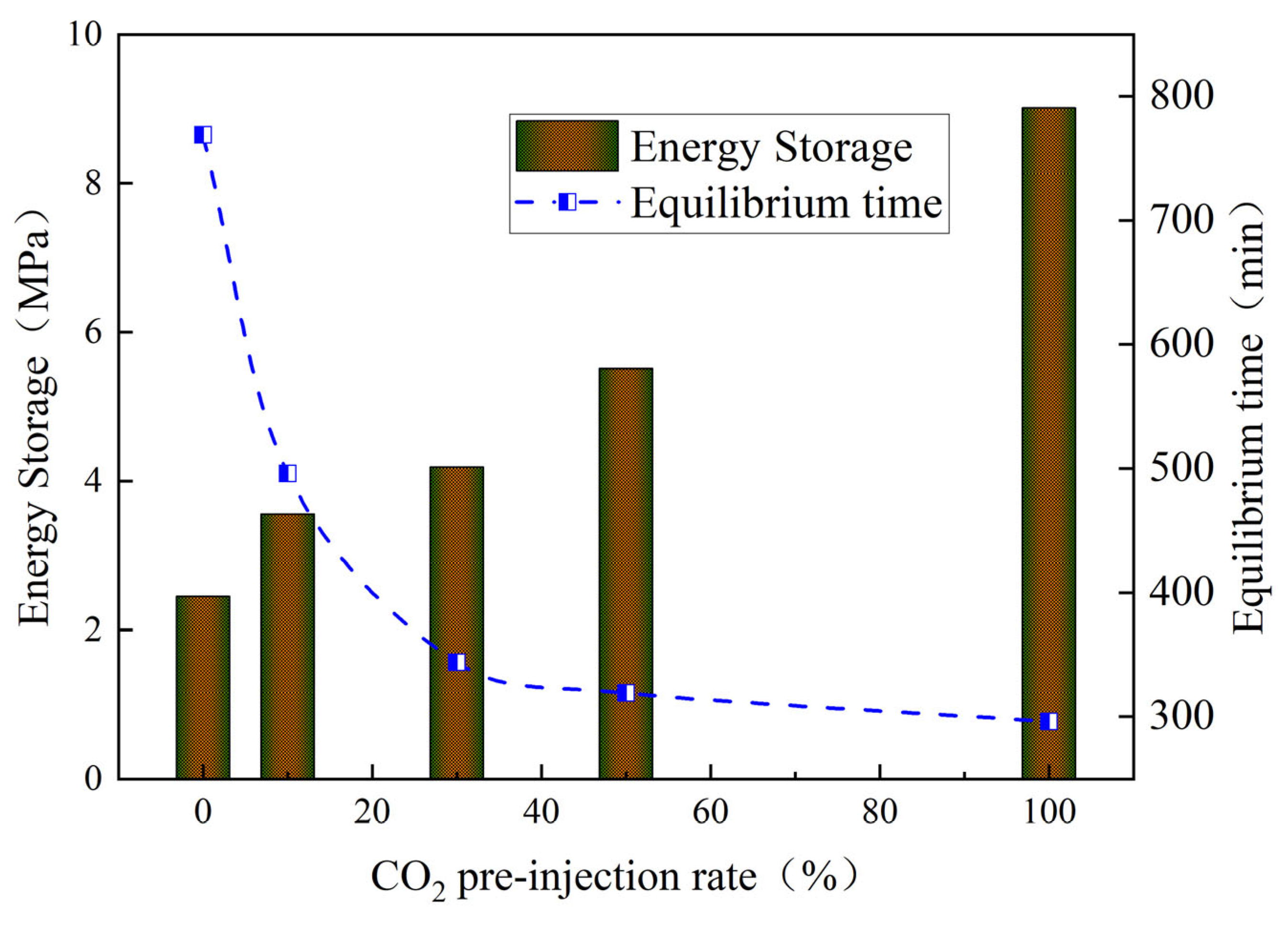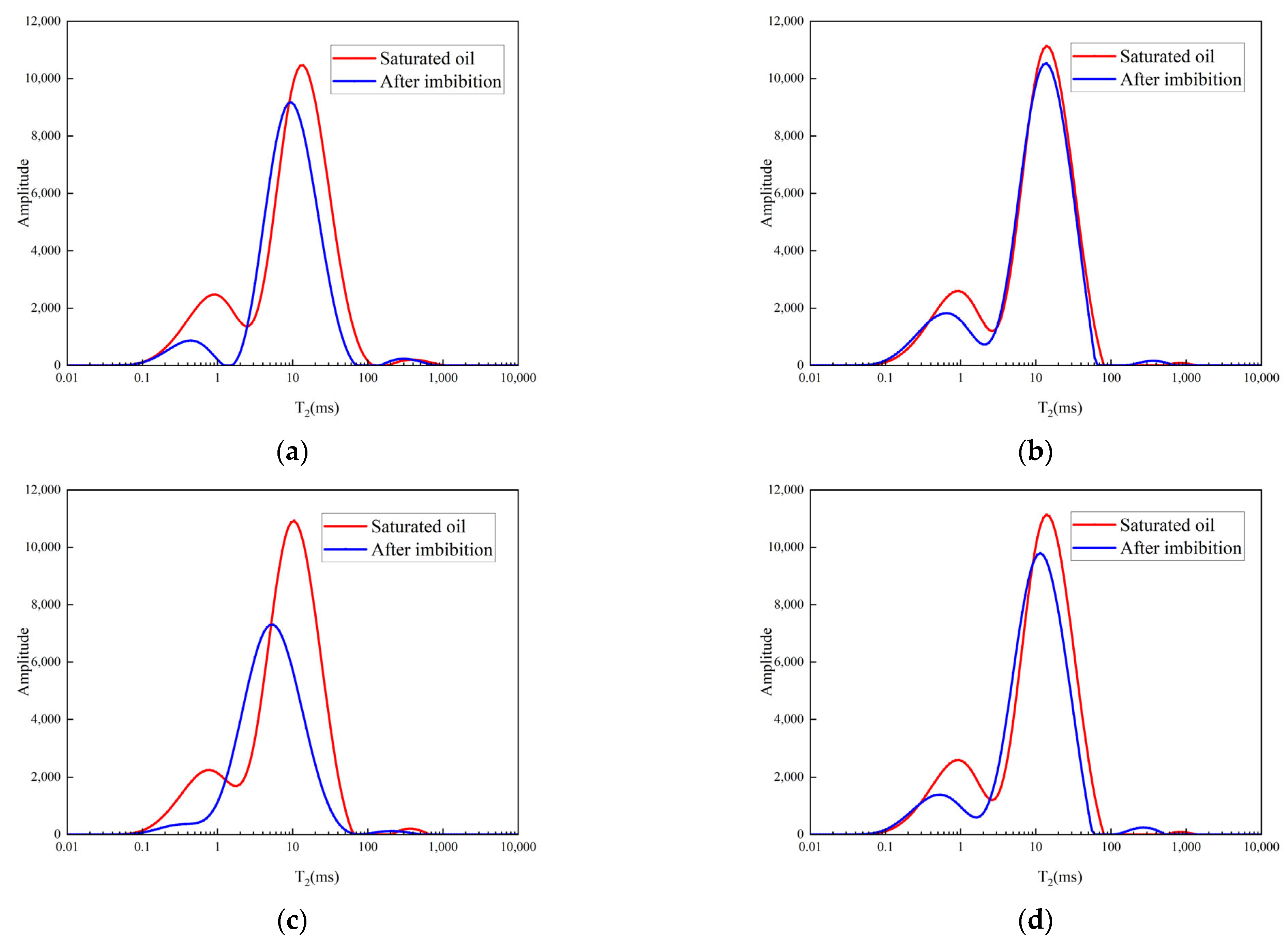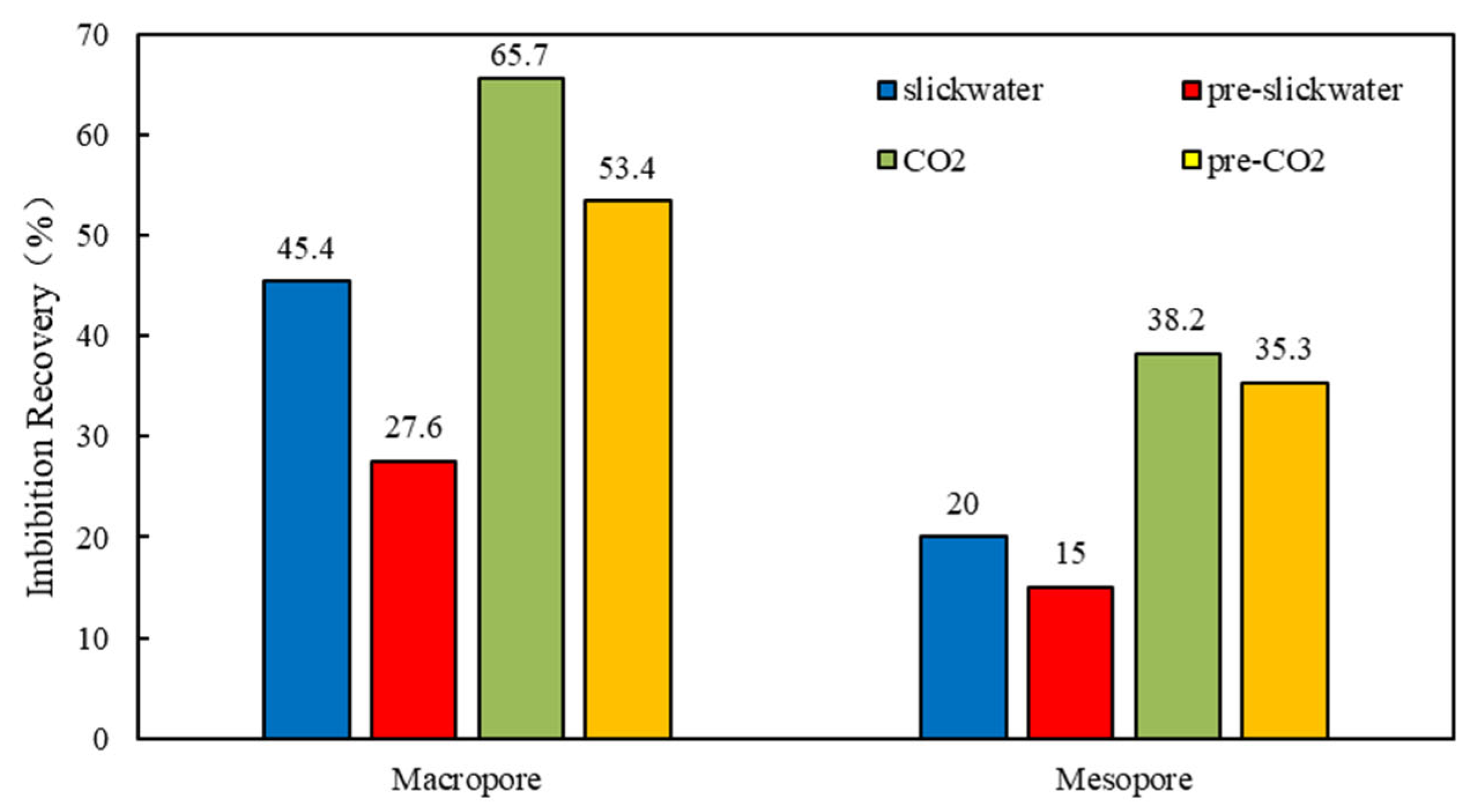Investigation on Energy Enhancement of Shale Oil Imbibition Under Different Fracture Fluid Injection Methods—A Case Investigation of Jimsar Lucaogou Formation
Abstract
1. Introduction
2. Experiment and Methods
2.1. Experimental Equipment
2.2. Materials
2.3. Experimental Methods
3. Energy Storage Effect of Fracturing Fluid
3.1. Energy Storage Effect Law
3.2. The Influence of Energy Storage on Porosity and Permeability
4. Optimization of CO2 Injection Volume and Well Shut-In Time
4.1. CO2 Pre-Injection Optimization
4.2. Optimization of Well Shut-In Time
5. Characteristics of Imbibition During the Energy Storage Period
6. Conclusions
- By measuring and comparing the pore permeability characteristics of the Jimsar core before and after energy storage, it was found that different fracturing fluids showed varying degrees of improvement in porosity and permeability after energy storage. Among them, CO2 pre-dissolved in the sliding water can be more dissolved in the sliding water, increasing the permeability of the rock core by about 1.26 times and the porosity by 11.4%. The pre-shut-in time of the sliding water can be appropriately extended to achieve the dissolution effect.
- The energy storage effects of four fracturing fluids were compared, namely pure CO2, CO2 pre-fracturing fluid, sliding water pre-fracturing fluid, and pure sliding water fracturing fluid. The results showed that, due to the high expansion coefficient and low interfacial tension of pure CO2, the energy storage effect of pure CO2 was the best, with an energy storage pressure of up to 7.85 MPa. The energy storage effect of pure sliding water fracturing fluid was the opposite, with an energy storage pressure of only 2.45 MPa.
- Considering factors such as comprehensive economy and energy storage efficiency, the optimal range for CO2 pre-load is between 20% and 30%. Based on a CO2 density of 770 kg/m3 (20 °C) and a single-stage fracturing fluid consumption of 2000 m3, it is recommended to use 308 t–462 t of on-site single-stage CO2 pretreatment.
- Based on the optimization criterion of energy storage pressure balance, the optimal shut-in time for CO2 should be 5 h and for slickwater 12.8 h.
- Compared with different types of fracturing fluids, CO2 can effectively utilize small pore crude oil in rock cores, while more mesopore crude oil is utilized on the basis of energy storage. The recovery of imbibition is about 29%, which is about 10% higher than that of slickwater.
- This research can provide assistance in determining the CO2 pre-injection and well shut-in time of the Jimsar Lucaogou Formation well area. The results provide theoretical support for energy storage fracturing construction in other shale oil reservoirs of the same type.
- This article has not yet given detailed consideration to the simulation of crack complexity setting and backflow stage after well shut-in. Subsequently, integrated experimental analysis of fracturing, shut-in, and backflow can be conducted on the full diameter scale physical model to obtain full life cycle analysis data of rock cores containing artificial fractures.
Author Contributions
Funding
Data Availability Statement
Conflicts of Interest
References
- Li, Q.; Li, Q.; Wu, J.; Li, X.; Li, H.; Cheng, Y. Wellhead Stability During Development Process of Hydrate Reservoir in the Northern South China Sea: Evolution and Mechanism. Processes 2025, 13, 40. [Google Scholar] [CrossRef]
- Li, Q.; Li, Q.; Cao, H.; Wu, J.; Wang, F.; Wang, Y. The Crack Propagation Behaviour of CO2 Fracturing Fluid in Unconventional Low Permeability Reservoirs: Factor Analysis and Mechanism Revelation. Processes 2025, 13, 159. [Google Scholar] [CrossRef]
- Caineng, Z.; Zhi, Y.; Rukai, Z.; Guosheng, Z.; Lianhua, H.; Songtao, W.; Shizhen, T.; Xuanjun, Y.; Dazhong, D.; Yuman, W.; et al. Progress in unconventional oil and gas exploration and development and theoretical technology in China. J. Geol. 2015, 89, 979–1007. [Google Scholar]
- Wang, R.; Hu, Z.; Dong, L.; Gao, B.; Sun, C.; Yang, T.; Wang, G.; Yin, S. Progress and Reflection on Shale Gas Reservoir Characterization and Evaluation Technology. Geol. Oil Gas 2021, 42, 54–65. [Google Scholar]
- Wang, Y.; Lu, Y.; Li, Y.; Wang, X.; Yan, X.; Zang, Z. Progress and Application of Unconventional Reservoir Fracturing Technology. J. Pet. 2012, 33, 149–158. [Google Scholar]
- Jin, Z.; Zhang, Q.; Zhu, R.; Dong, L.; Fu, J.; Liu, H.; Yun, L.; Liu, G.; Li, M.; Zhao, X.; et al. Classification and significance of continental shale oil in China. Geol. Oil Gas 2023, 44, 801–819. [Google Scholar]
- Wang, Q.; Tao, S.; Guan, P. Research and Exploration and Development Progress of Shale Oil in Continental Basin of China. Nat. Gas Geosci. 2020, 31, 417–427. [Google Scholar]
- Xiong, X.; Hao, M. The damage mechanism and protection technology of low porosity and low permeability reservoirs. Liaoning Chem. 2013, 42, 1223–1225. [Google Scholar]
- You, L.; Xie, B.; Yang, J.; Kang, Y.; Han, H.; Wang, L.; Yang, B. The damage mechanism of a shale gas well fracturing fluid backflow on reservoir fractures. Nat. Gas Ind. 2018, 38, 61–69. [Google Scholar]
- Liang, T.; Zhou, F.; Lu, J.; DiCarlo, D.; Nguyen, Q. Evaluation of Wettability Alteration and IFT Reduction on Mitigating Water Blocking for Low-Permeability Oil-Wet Rocks after Hydraulic Fracturing. Fuel 2017, 209, 650–660. [Google Scholar] [CrossRef]
- Hu, J.; Zhao, H.; Du, X.; Zhang, Y. An analytical model for shut-in time optimization after hydraulic fracturing in shale oil reservoirs with imbibition experiments. J. Pet. Sci. Eng. 2022, 210, 110055. [Google Scholar] [CrossRef]
- Song, Y.; Zhou, L.; Guo, X.; Guo, X.; Chang, Q.; Wang, X. Characteristics and distribution of lacustrine cloud tight oil reservoirs in Lucaogou Formation of Jimusar Sag, the Junggar Basin. J. Rock Sci. 2017, 33, 1159–1170. [Google Scholar]
- Wang, J.; Zhou, L.; Liu, J.; Zhang, X.; Zhang, F.; Zhang, B. Characteristics of acid alkali alternative diagenesis of the Permian Lucaogou Formation in Jimusar Sag, the Junggar Basin and its impact on shale reservoirs. Pet. Explor. Dev. 2020, 47, 898–912. [Google Scholar] [CrossRef]
- Zheng, M.; Li, J.; Wang, W.; Li, P.; Yang, H.; Wu, X.; Yu, J. Analysis of tight reservoir oil filling and accumulation process: Take the Permian Lucaogou Formation in Jimusar Sag of the Junggar Basin as an example. Earth Sci. 2018, 43, 3719–3732. [Google Scholar]
- Wei, C.; Wei, D.; Huang, L.; Li, Z. Geochemical characteristics and genesis of Permian heavy oil in Jimusaer Depression, Xinjiang. Nat. Gas Geosci. 2012, 23, 135–140. [Google Scholar]
- Ma, S.; Yang, S.; Lv, D.; Kou, G.; Yang, L.; Lei, H. A Study on the Elastic Recovery Law and Influencing Factors of Tight Reservoirs: Taking the Lucaogou Formation in the Jimusaer Basin of Xinjiang as an Example. Sci. Technol. Eng. 2016, 16, 147–151+156. [Google Scholar]
- Zhang, H. Practice and understanding of improving oil recovery by CO2 mixed phase flooding. Daqing Pet. Geol. Dev. 2020, 39, 114–119. [Google Scholar]
- Kamari, A.; Arabloo, M.; Shokrollahi, A.; Gharagheizi, F.; Mohammadi, A.H. Rapid method to estimate the minimum miscibility pressure (MMP) in live reservoir oil systems during CO2 flooding. Fuel 2015, 153, 310–319. [Google Scholar] [CrossRef]
- Sugai, Y.; Babadagli, T.; Sasaki, K. Consideration of an effect of interfacial area between oil and CO2 on oil swelling. J. Pet. Explor. Prod. Technol. 2014, 4, 105–112. [Google Scholar] [CrossRef]
- Bikkina, P.; Wan, J.; Kim, Y.; Kneafsey, T.J.; Tokunaga, T.K. Influence of wettability and permeability heterogeneity on miscible CO2 flooding efficiency. Fuel 2016, 166, 219–226. [Google Scholar] [CrossRef]
- Sang, S.; Yuan, L.; Liu, A.; Sang, S.; Yuan, L.; Liu, A.; Han, S.; Zheng, S.; Liu, T.; Zhou, X.; et al. Carbon Neutrality Geological Technology and Its Prospective Application in Low Carbonization of Coal. J. Coal Sci. 2022, 47, 1430–1451. [Google Scholar]
- Torabi, F.; Asghari, K. Effect of operating pressure, matrix permeability and connate water saturation on performance of CO2 huff-and-puff process in matrix-fracture experimental model. Fuel 2010, 89, 2985–2990. [Google Scholar] [CrossRef]
- Alfarge, D.; Wei, M.; Bai, B. Factors affecting CO2-EOR in shale-oil reservoirs: Numerical simulation study and pilot test s. Energy Fuels 2017, 31, 8462–8480. [Google Scholar] [CrossRef]
- Hu, Y.; Hao, M.; Chen, G.; Sun, R.; Li, S. Technologies and practice of CO2 flooding and sequestration in China. Pet. Explor. Dev. 2019, 46, 753–766. [Google Scholar] [CrossRef]
- Zou, Y.; Li, Y.; Li, S. The effect of CO2 pre injection on the morphology of shale fracturing fractures and rock properties. Nat. Gas Ind. 2021, 41, 83–94. [Google Scholar]
- Ding, Y.; Ma, X.; Ye, L.; Xiao, Y.; Zhang, Y.; Gu, Y.; Ma, C. Research on CO2 rock breaking mechanism and fracturing technology. Lithol. Oil Gas Reserv. 2018, 30, 151–159. [Google Scholar]
- Wang, F.; Wu, B.; Liao, K.; Shi, S.; Zhang, S.; Li, J.; Suo, J. Inversion of Fracture Parameters and Formation Pressure for Fractured Horizontal Wells in Shale Oil Reservoir Based on Soaking Pressure. Xinjiang Pet. Geol. 2022, 43, 624–629. [Google Scholar]
- Xu, J.; Wang, M.; Wang, J.; Sun, H.; Wang, L. Practice and understanding of volume fracturing technology for horizontal wells in Jimsar shale oil reservoir. Xinjiang Oil Gas 2024, 20, 23–29. [Google Scholar]
- Li, B. Investigation into Stimulation Mechanism of CO2 Pre-pad Energized Fracturing in Jimusar Shale Oil Reservoir. Ph.D. Thesis, China University of Petroleum, Beijing, China, 2023. [Google Scholar] [CrossRef]
- Xu, T.; Wu, C.; Chen, Y.; Zhang, J.; Luo, H.; Zhao, J.; Wang, L. Numerical simulation study on CO2 pre fracturing of Jimsar shale oil. In Proceedings of the 2022 International Conference on Oil and Gas Field Exploration and Development II Jiqing Oilfield Operation Area of Xinjiang Oilfield Branch, Xi’an, China, 16–18 November 2022; Volume 13. [Google Scholar]
- Sun, X.; Wang, H.; Li, Y.; Zheng, Y.; Lu, Q. Experimental study on sand carrying in supercritical CO2 horizontal annulus. Pet. Drill. Technol. 2022, 50, 17–23. [Google Scholar]









| Field-Scale (Single Stage) | Experimental Scale | |||
|---|---|---|---|---|
| Parameters | Near Fracture | Far Fracture | Parameters | Core sample |
| Fracture length (Lf)/m | 260 | 260 | Core length (L)/cm | 6 |
| Fracture height (hf)/m | 24 | 24 | Core radius (r)/cm | 1.25 |
| Clusters (n) | 5 | 5 | Porosity (φ)/% | 13 |
| Half-cluster spacing (Cf)/m | 0.06 | 3.94 | Calculation formula | L × π × r2 × φ |
| Porosity (φ)/% | 13 | 13 | Crude oil volume/cm3 | 3.82 |
| Calculation formula | Lf × hf × n × Cf × φ × 2 | Fracturing fluid/cm3 | 16 | |
| Crude oil volume/m3 | 486.72 | 31,961.28 | Remote crude oil volume/cm3 | 256 |
| Fracturing fluid: Near fracture crude oil: Remote crude oil | 2000:486.72:31,961.28 ≈4:1:64 | Fracturing fluid: Near fracture crude oil: Remote crude oil | 15.5:3.82:244 ≈4:1:64 | |
| Core | Mass/g | Diameter/cm | Length/cm | Lithology | Permeability/mD | Porosity/% |
|---|---|---|---|---|---|---|
| J0 | 54.25 | 2.47 | 5 | Grey mudstone sandstone | 0.15 | 14.45 |
| J1 | 53.35 | 2.53 | 5 | Grey mudstone sandstone | 0.16 | 16.49 |
| J2 | 53.27 | 2.50 | 5 | Grey mudstone sandstone | 0.141 | 15.58 |
| J3 | 53.64 | 2.51 | 5 | Grey mudstone sandstone | 0.158 | 15.79 |
| J4 | 53.38 | 2.52 | 5 | Grey mudstone sandstone | 0.132 | 11.85 |
| J5 | 53.22 | 2.50 | 5 | Grey mudstone sandstone | 0.096 | 16.41 |
| J6 | 53.15 | 2.50 | 5 | Grey mudstone sandstone | 0.073 | 13.22 |
| Core Number | Experimental Scheme | Energy Storage Method |
|---|---|---|
| J0 | Tradition | 10 MPa slickwater |
| J1 | Pure Slickwater | 10 MPa slickwater |
| J2 | Pre-Slickwater | 5 MPa slickwater + 5 MPa CO2 |
| J3 | Pure CO2 | 10 MPa CO2 |
| J4 | Pre-CO2 | 5 MPa CO2 + 5 MPa slickwater |
| J5 | 3 MPa CO2 + 7 MPa slickwater | |
| J6 | 1 MPa CO2 + 9 MPa slickwater |
| Core Number | Experimental Scheme | Initial Permeability/mD | Post-Experiment Permeability/mD | Growth Rate/% | Initial Porosity/% | Post-Experiment Porosity/% | Growth Rate/% |
|---|---|---|---|---|---|---|---|
| J1 | Pure Slickwater | 0.16 | 0.166 | 3.8 | 16.49 | 16.71 | 1.35 |
| J2 | Pre-Slickwater | 0.141 | 0.320 | 126.6 | 15.58 | 17.36 | 11.4 |
| J3 | Pure CO2 | 0.158 | 0.180 | 13.9 | 15.79 | 16.08 | 1.83 |
| J4 | 5 MPa CO2 + 5 MPa slickwater | 0.132 | 0.148 | 12 | 11.85 | 11.99 | 1.15 |
| Core Number | Experimental Scheme | Imbibition Recovery, % | Lower Limit of Pore Utilization, μm |
|---|---|---|---|
| J1 | slickwater | 20.4 | 0.02525 |
| J2 | pre-slickwater | 18.5 | 0.02579 |
| J3 | CO2 | 30.5 | 0.02501 |
| J4 | pre-CO2 | 28.5 | 0.02509 |
Disclaimer/Publisher’s Note: The statements, opinions and data contained in all publications are solely those of the individual author(s) and contributor(s) and not of MDPI and/or the editor(s). MDPI and/or the editor(s) disclaim responsibility for any injury to people or property resulting from any ideas, methods, instructions or products referred to in the content. |
© 2025 by the authors. Licensee MDPI, Basel, Switzerland. This article is an open access article distributed under the terms and conditions of the Creative Commons Attribution (CC BY) license (https://creativecommons.org/licenses/by/4.0/).
Share and Cite
Zhu, J.; Wang, F.; Wang, J.; Li, Z.; Zhang, S. Investigation on Energy Enhancement of Shale Oil Imbibition Under Different Fracture Fluid Injection Methods—A Case Investigation of Jimsar Lucaogou Formation. Energies 2025, 18, 1412. https://doi.org/10.3390/en18061412
Zhu J, Wang F, Wang J, Li Z, Zhang S. Investigation on Energy Enhancement of Shale Oil Imbibition Under Different Fracture Fluid Injection Methods—A Case Investigation of Jimsar Lucaogou Formation. Energies. 2025; 18(6):1412. https://doi.org/10.3390/en18061412
Chicago/Turabian StyleZhu, Jian, Fei Wang, Junchao Wang, Zhanjie Li, and Shicheng Zhang. 2025. "Investigation on Energy Enhancement of Shale Oil Imbibition Under Different Fracture Fluid Injection Methods—A Case Investigation of Jimsar Lucaogou Formation" Energies 18, no. 6: 1412. https://doi.org/10.3390/en18061412
APA StyleZhu, J., Wang, F., Wang, J., Li, Z., & Zhang, S. (2025). Investigation on Energy Enhancement of Shale Oil Imbibition Under Different Fracture Fluid Injection Methods—A Case Investigation of Jimsar Lucaogou Formation. Energies, 18(6), 1412. https://doi.org/10.3390/en18061412






